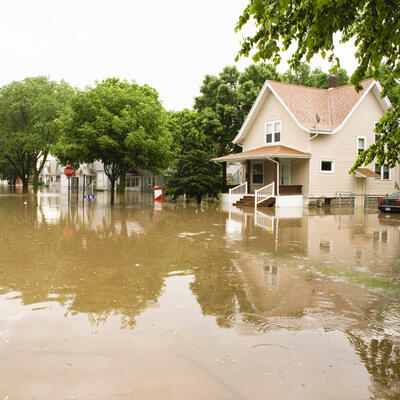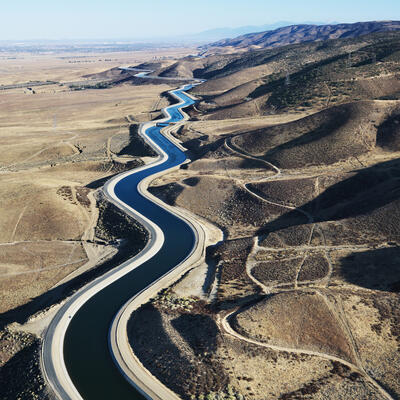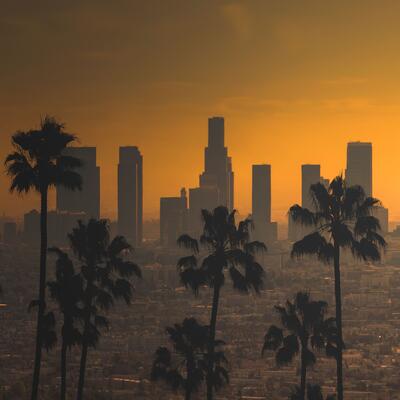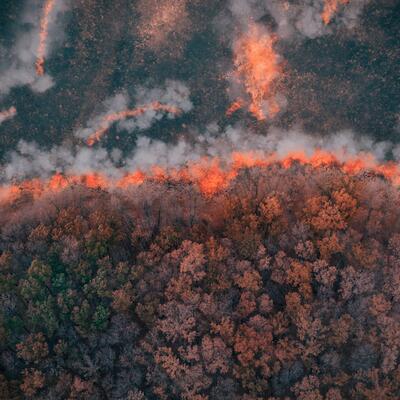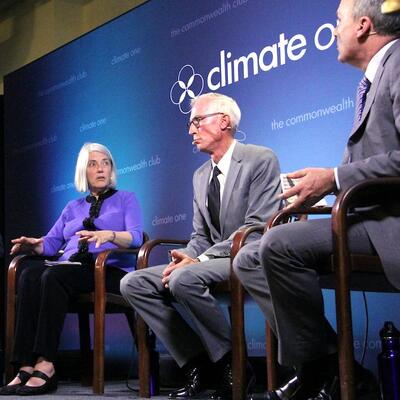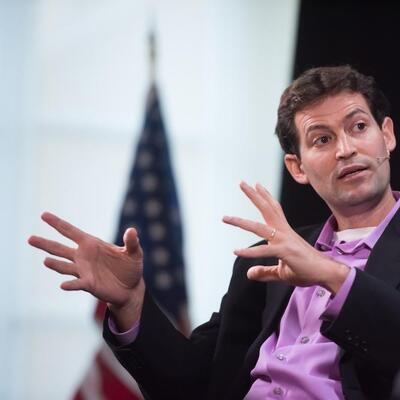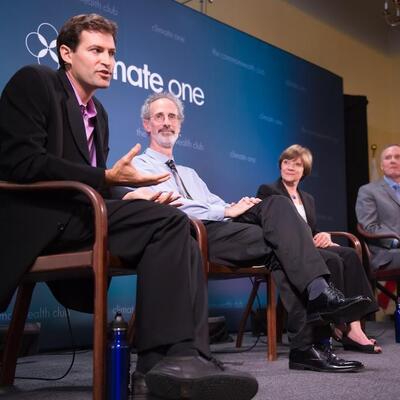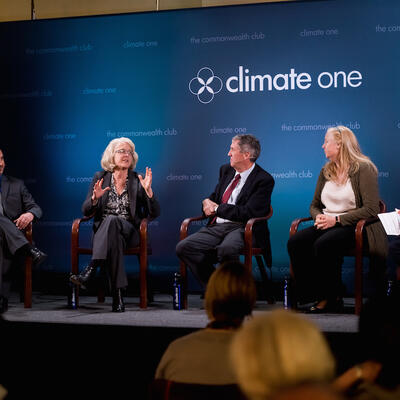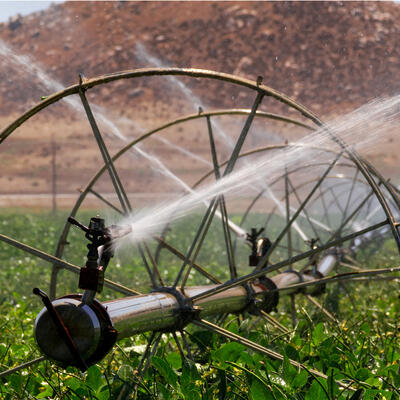
The Land of Dreams and Drought
Guests
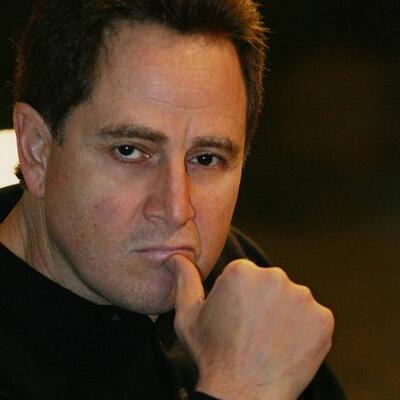
Mark Arax
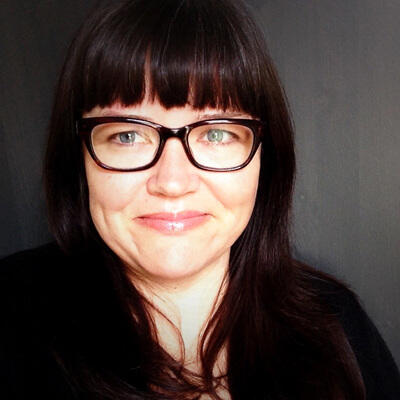
Faith Kearns
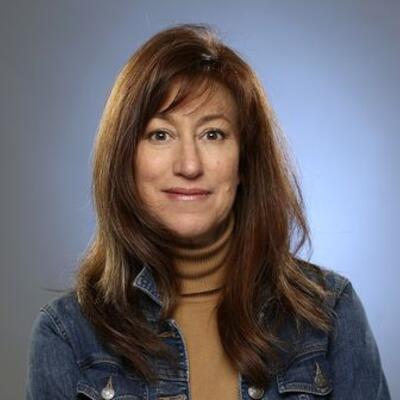
Diana Marcum
Summary
The California dream, with its promise of never-ending sunshine, fertile soil and rivers running with gold, has been beckoning people west for over two hundred years. But making that dream come true for an ever-increasing population has taken its toll on the landscape. Is the California dream coming to an end?
When its current water system was built in the 1960s and ‘70s, California’s population was about half of the forty million who live there today. And every one of its citizens needs water to drink, bathe and cook. Add to that the demands of agriculture, livestock and the natural ecosystem, and the pool of available water gets smaller and smaller.
“When the resource is finite then you have to make choices,” says author Mark Arax. “And so in the San Joaquin Valley they're gonna have to choose which land deserves that water. It's alfalfa, it's Holsteins.”
In his new book, The Dreamt Land: Chasing Water and Dust Across California, Arax pulls back the curtain on the backroom deal-making between billionaire investors and regulators that has, in some cases, stolen the water right out from under our feet. Faith Kearns, a scientist with the California Institute for Water Resources, says it’s been going on for years. Even she has trouble keeping up.
“I think there is a lot of stuff that goes on really behind the scenes and that is completely inaccessible to most of us, even those of us who work on this topic professionally,” says Kearns.
California now experiences regular weather whiplash, amplified by climate change, careening between record drought and extreme rainfall. Diana Marcum won a Pulitzer Prize for her series of articles on California’s central valley farmers during the drought. Years of parched weather have taught her to appreciate the green times we do get.
“I think that’s one thing I took away from the drought,” Marcum recalls. “During it I kept thinking, I wish I would've paid more attention. I wish I could picture the snow. I wish I could picture the grass.
So right now I'm trying to look so hard that it almost hurts”
This program was recorded in front of a live audience at The Commonwealth Club of California in San Francisco on July 17th, 2019.
Resources From This Episode (4)
Full Transcript
Greg Dalton: This is Climate One, changing the conversation about energy, the economy, and the environment.
The California dream, with its promise of never-ending sunshine, fertile soil and rivers running with gold, has been beckoning people west for over two hundred years.
Diana Marcum: People came from all over the world and they didn't have a lot to get started. So that's exactly the places where some of our most beautiful and interesting cultures are.
Greg Dalton: But making that dream come true for an ever-increasing population has taken its toll on the landscape.
Mark Arax: The invention of California required the invention of a system to move the water from, you know, 750, 1,000 miles. And so I think that qualifies as hubris.
Greg Dalton: And as climate change fuels horrific fires, drought and power struggles over diminishing water, the California dream may be coming to an end – at least for some of its citizens.
The land of dreams and drought. Up next on Climate One.
Greg Dalton: Could the California dream be coming to an end?
Climate One conversations feature oil companies and environmentalists, Republicans and Democrats, the exciting and the scary aspects of the climate challenge. I’m Greg Dalton.
Greg Dalton: California’s water system was built in the 1960s and 70s when the state had about half of the 40 million people who live there today. And every one of its citizens needs water to drink, bathe and cook. But only about 10 percent of the state’s water is used in urban areas. Half flows to the environment, supporting ecosystems and recreation, and 40 percent goes to agriculture.
Mark Arax: Well, when the resource is finite then you have to make choices. And so in the San Joaquin Valley they're gonna have to choose which land deserves that water. It's alfalfa, it's Holsteins.
Greg Dalton: Mark Arax is the author of The Dreamt Land: Chasing Water and Dust Across California. Arax landed rare interviews with Stuart and Lynda Resnick, secretive billionaires who own Fiji Water and grow hundreds of millions of pounds of water-hungry pistachios and almonds. And he pulls back the curtain on the backroom deal-making that has, in some cases, stolen the water right out from under our feet.
Greg Dalton: Faith Kearns, a scientist with the California Institute for Water Resources, says it’s been going on for years. Even she has trouble keeping up.
Faith Kearns: I think there is a lot of stuff that goes on really behind the scenes and that is completely inaccessible to most of us, even those of us who work on this topic professionally.
Greg Dalton: California and other western states now experience regular weather whiplash, amplified by climate change, careening between record drought and extreme rainfall. Diana Marcum covers water, wildfire and drought for the Los Angeles Times. Years of parched weather have taught her to appreciate the green times we get.
Diana Marcum: I think that’s one thing I took away from the drought was like during it I keep thinking I wish I would've paid more attention. I wish I could picture the snow. I wish I could picture the grass. So right now I'm trying to look so hard that it almost hurts.
Greg Dalton: Marcum, Kearns and Arax joined me to talk about the future of the California dream in the era of climate disruption. In his new book, Mark Arax calls the invention of California a “mad act of hubris.”
Mark Arax: Well, we took the edge of a continent a thousand miles long and we drew a line around it and called it a state. And then we proceeded to try to make each different state of nature inside that, there's a dozen of them, equal. And so that the invention of California required the invention of a system to move the water from, you know, 750,000 miles. And so I think that qualifies as hubris.
Greg Dalton: so that hubris that you write about, you know. Tell us a little more about that and how it's manifest with the system we’re living with today.
Mark Arax: Okay. So it starts with the first taking which is the taking of the body of the native Californian. We had the most concentrated population of indigenous anywhere in North America 300,000 natives. And when Father Serra came up through Mexico and started his missions that was the taking of the body of the Indian and that allowed for the taking of the rivers. And then we see Sutter coming in to Northern California, gold being discovered and the erecting of the system that allowed us to -- that's the first, you know, the mining of gold is really the mining of water first. And so you see the flumes which are nothing but irrigation canals made out of wood. You see dams and ditches and this really intensive experiment going on to move the water so it has a great deal of erosive power to unearth the gold.
And then at some point in the 1880s, the silting of the rivers end up damaging, doing great damage to the alluvial plains and California has a choice. Do we mine gold, do we mine soil? And so the industrialists who made all the money off gold they end up living in Nob Hill in San Francisco and farming the hinterlands and they plant wheat. So that was the industrialization beginning from mountain down to valley floor.
Greg Dalton: And then we’ll get in to more of what happens on that valley floor. Diana Marcum, during the drought you wrote about a number of characters quite vividly that earned you the Pulitzer Prize. What are some of those characters whether it's Diana Johnson or Fred Lou John or others that -- tell us their story, you painted these very vivid portraits during the drought.
Diana Marcum: When the drought first started, not everybody knew about it. It hit the outlying agricultural towns first. And there was just this incredible hardships there that people were pretty unaware of even in Fresno, you know, certainly not in San Francisco and not in Sacramento, where it would've maybe mattered. And there were people whose wells were going dry and there was no civic organization, you know, responsible, no government organization because it’s your own well. So they would call and there was nothing to be done but people didn't -- I don’t think anybody official understood how much suffering was out there.
And then this one woman’s well went dry and she started thinking well I wonder how many other people's wells are drying. So she started going on these roads that nobody drives out to the mobile home out to the places that are really off, you know, off the beaten track. And she found out all these people that didn't have water and then she thought well as long as I'm counting I’ll bring them some water.
So then in their little local paper she had them put a notice with her phone number and her address and said she was doing this in case anybody wanted to bring water. And the next day she came out of her house and her whole backyard and her garage was just full of pallets of water because people knew, they knew how bad it was. So that kind of sticks with me.
And then after the drought left the Central Valley and kind of moved on to the rest of California, I moved on to another project. Where a photographer named Rob Gossi and I we just drove around California with no particular plan. And we were kind of doing this Tumbler thing, just live to see how much the rest of California was aware of what was going on, which was then the nucleus of it. And it had hit everywhere and there were just these random stories that would even now are just kind of burned into my mind like we’re driving down the road and we see this old man with a bucket of water, watering his rose bushes. And it was a rose that his wife who had died had planted and he was trying to keep it alive during the drought. So he would wash his dishes and then he would the leftover water to water this rose that meant so much to him.
All these people that were making these tremendous personal sacrifices and using hardly any water. And at the same time like that’s not gonna make a difference, right. All of the people that you are writing about are the ones that, you know, that could maybe, possibly change things. But there's these other people making these just horrible, horrible choices.
Greg Dalton: And we’ll get into that. So there’s a huge users of water and the small users of water and there’s the others. The disparity in water like there is a lot of other things, wealth and power in our state and country.
Diana Marcum: But I think there’s also that, you know, there is sort of a rural small-town thing that you take care of each other. So, you know, if you're living by like Oroville, which is one of like that provides a lot of water for California and you're watching it go down outside your window and you're just watching the boats on dry land and you’re watching it drop and you know that's the water people drink then you start throwing in and doing your part.
Greg Dalton: Faith Kearns, let’s bring climate into this conversation. How much is, you know, climate contributing to these, you know, the stress. Mark Arax has said that it’s kind of crazy to build California the way it was in a certain period. Now climate is kind of making that equation different. How is it changing the water equation?
Faith Kearns: I think we have a growing sense that our particularly our water infrastructure was built for a very different time when there was a lot more water coming down and particularly snow, so precipitation in general. And so what we're seeing is that as temperatures warm which every year over the past many years has been the warmest year on record and then the warmest year on record. The way that we’ve built our water infrastructure to essentially have these large dams that capture snowmelt and are intended to do that gradually over the course of the dry summer, the dry season in California, you know, is really challenging when more of that precipitation is falling as rain. And so what we saw on 2016 when we had a particularly rainy year that kind of ended the drought was that, you know, we ended up with an emergency at Oroville, right because there's too much water. And so things are --
Greg Dalton: So it was that dam that almost burst, yeah.
Faith Kearns: Yeah, I mean there were a lot of other things going on there but it does challenge our basic ability to kind of think about water in the way that we’ve always thought about it.
Greg Dalton: Faith Kearns. Why should someone outside California who doesn't drink California water care about what happens to the water in California?
Faith Kearns: Might stump me with that.
Greg Dalton: Well, I mean we export a lot of food whether you think if you live in the Midwest you consume a lot of California water and fruits or nuts, you don’t drink California water that’s one way the fruits and vegetables that come out of the state matters.
Faith Kearns: Yeah, I can see that argument for sure.
Mark Arax: I think to use a cliché the canary in the coal mines. We got Florida, we got the Mississippi, you’ve got California. We don't need climate change to swing wildly between drought and flood. Early in my book, I list the drought years and the flood years and it goes on for several sentences. So when you're that inherent kind of nature that we have and then you add on to that it links up to climate change. We’re gonna see havocs that have never been created before and we’re seeing that already. We saw in Paradise the whole place burning off the California map. So I think we’re going to be showing the way for the rest of the country. And so I think it's important to pay attention to what California is doing right and wrong.
Diana Marcum: Well, also don’t you think we’re a kind of a key part of the conversation because of the Central Valley and because we have droughts and floods and droughts and floods and it’s natural.
Mark Arax: That's right.
Diana Marcum: It’s harder to convince, used to be harder to convince people about climate change because they’d say no, this is just California.
Mark Arax: Right. California being California.
Greg Dalton:: You’re listening to a Climate One conversation about climate change and water. Coming up: will there be enough to go around?
Mark Arax: In my lifetime the populations of California has gone from 11 million to 40 million. And the system wasn't designed for that; the system’s certainly not gonna see us into a future of more houses and more almonds. So something has to give.
Greg Dalton: That’s up next, when Climate One continues.
Greg Dalton: This is Climate One. I’m Greg Dalton, and we’re talking about water use in the west. My guests are Diana Marcum of the Los Angeles Times, Faith Kearns of the California Institute of Water Resources and Mark Arax, author of The Dreamt Land: Chasing Water and Dust Across California.
Greg Dalton: Farmers in the central valley have been hard hit by the drought. In recent years we’ve seen a push away from flood irrigation toward drip irrigation as means of conserving water. But now, Faith Kearns and other experts are flipping on flooded crops.
Faith Kearns: You know, for a long time there was a focus on water use efficiency and that's where sort of drip irrigation technology came from, right. You used to just irrigate in furrows or flood or that kind of thing and so the idea was, oh, if we can just make every drop work to its fullest and then things will be good.
And then I think what’s happened over time is people have seen that water use efficiency isn’t the same thing as water conservation, right. So what people have been doing is instead of just using their water efficiently, they take what they have saved and apply it to something else. So there is now sort of like net water conservation happening. And then the other thing that sort of come up in the last few years is just related to again and Mark has written extensively about groundwater withdrawal and subsidence which is land sinking in the Central Valley. And the fact that drip irrigation is so efficient that it doesn't help us to recharge groundwater in any way. And so now what you’re seeing is people making a move back towards studying how flood irrigation back to the beginning sort of full circle can be used as a groundwater recharge tool.
Greg Dalton: Mark Arax, this sounds crazy because we’ve done conversations here about kind of shaming farmers for flooding. Spend money to drip and now, no, go back to flooding, that’s just --
Mark Arax: There’s just paradox of drip. The farmer, his yields are so much higher with drip that he takes those lines and he goes uphill now where farming never was. And then he's taking up land that is so poor that it wasn't even for pasturage. But because the drip can deliver a precise dose of water and chemical to a root zone, you don't need good earth. So they’re farming that if you look at the footprint of agriculture in the Central Valley it's gone from the primo alluvial plain soil that was when the rivers were first taken turned into canals. And then when the advent of the turbine pump came in 1920, the year my grandfather arrived here, then you started seeing the extraction of the aquifer. And you started seeing the footprint of agriculture go from prime land to not so prime. And now with drip we’re actually farming millions of acres of poor land. And this is the land that will probably come out of development when the groundwater regulation law goes into full effect.
Greg Dalton: So are you saying that's a good thing or a bad thing, you know, making water go further and it’s getting food off of land that didn't previously produce food.
Mark Arax: Well, when the resources finite then you have to make choices. And so on the San Joaquin Valley they're gonna have to choose which land deserves that water. And you will see in the San Joaquin Valley there's 6 million acres of farmland it'll probably go down to 4.5 because they've decided to idle the land that an argument can be made, a strong argument should have never been farmed in the first place. It's alfalfa, it's Holsteins; we need to find a place other than California that where cows are truly happy because our land and water is too valuable for Holsteins. That’s gonna upset all your Azorean Portuguese friends --
Diana Marcum: They’re already moving.
Mark Arax: Diana’s most recent book is about the Azorean Portuguese in the valley and then she goes back to the islands and that's that culture that I'm gonna upset. So you’re gonna have to watch my back now.
Diana Marcum: Yeah, I mean there’s this even if it shouldn’t be there we have all of these groups all these cultures that are parts of those places. Those places that should've never been farmed before are the places that people came from all over the world and they didn't have a lot to get started. So that's exactly the places where some of our most beautiful and interesting cultures are and that's where our stories are. I mean we’re losing so much more than, you know, this many acres of drip irrigation we’re going to lose this incredibly close knit towns. These cultures that like I wrote about it --
Mark Arax: _____ the Black Okies.
Diana Marcum: _____ the Black Okies and the Azoreans _____ in Turlock, all these people that came, they came and they brought all their traditions and they lived in really isolated places and they lived together. So all of that got passed down you know whether they were from Mexico or whether they were from Punjab or whether they were from the Azores. And these isolated towns out in these like vast farmlands those are the ones that --
Mark Arax: Yeah, they’re gonna wither
Greg Dalton: And those places you go that most people in California don't even know exist and certainly don’t go. If you’re just joining us we’re talking about water at Climate One. I’m Greg Dalton. My guests are Mark Arax, Diana Marcum and Faith Kearns.
California has abundant water this year but some investors are betting that water constraints in the future will drive prices upward. Ry Rivard covers water and power for the Voice of San Diego. He’s reported on land and water rights purchases in Southern California that suggest speculation by some unusual investors. Over the past several years, a company called Renewable Resources Group has bought land in the Imperial Valley. In one case, it re-sold land within a couple of years for about double the price to the Metropolitan Water District of Southern California, which provides water to nearly 20 million people.
We talked to Ry Rivard about what these secretive deals worth hundreds of millions of dollars might mean for the future of California water.
Ry Rivard: If you look at the Imperial Valley in particular, it's really desert. The only reason it's a big farming area is because they diverted the Colorado River into their Valley. Renewable Resources Group this Los Angeles-based company that does water, land and energy development. Renewable came in working with Harvard as the sort of silent partner the Harvard Foundation and bought a bunch of land. They knew that people were interested in the water that came with this land. We’re talking, you know, multi-million-dollar deals for thousands, tens of thousands of acres of land.
So much of water in California a lot of this water trading happens beneath the radar. There could be other companies that we don't even know about. There’s so little freshwater in the world some of it is getting polluted some of it is being rearranged by climate change in unpredictable ways. So betting on making money from water is a good bet as water becomes scarcer.
I think we really need to start paying more attention to who these people are who these actors are who these lobbyists and officials, many of them unelected are and who these companies are. And if we don't I think we could find ourselves subject to prices in situations and scarcity real or artificial that we could've prevented or dealt with or anticipated if we’d just been paying more attention.
Greg Dalton: That was Ry Rivard from the Voice of San Diego. Faith Kearns, water markets are controversial, but water is unique in some respects as both a commodity and the UN has declared a human right to water. So it's both a right and a commodity. Your take there on sort of, you know, investing; is that necessarily bad to be trading water rights?
Faith Kearns: So I’m not a money person I’m an ecologist by training. And so for me, yes, I think it’s a bad thing. Do I have some other solution per se? No. I am not a huge fan of the water market conversation. I think for me what I’ve, you know, kind of come to over the last many years of working on this issue in California is that there is a lot of stuff that goes on really behind the scenes and that is completely inaccessible to most of us even those of us who work on this topic professionally. In a way that’s pretty disturbing for me.
And I think, you know, I’d actually like to see us move in a completely different direction which is back to the idea of, you know, water really as a public -- I don’t even like the word resources how radical I’m getting these days is, you know, it belongs to all of us. And so this idea that you've got kind of the 1%, you know, capitalizing even further on this finite resource is incredibly disturbing to me. And I am really grateful for people like Ry and Mark who actually spend the time to kind of figure out what's going on behind the scenes. I’ve sat with certainly colleagues, talking about how we feel, you know, like our hands are tied behind our back a little bit because we aren’t operating in that same financial space that other people are. And we’re kind of running around trying to do the best we can, but also these forces are so much bigger than any of us.
Greg Dalton: Mark Arax. We live in an economy where most everything is traded there's marketplaces for all sorts of things, parking spaces, etc. But somehow people think differently about water.
Mark Arax: Selling water. It is a problem -- it belongs to all of us but this water like Imperial it was captured before 1914, they have these rights to use that water beneficial use. And we have, I won’t get in all the complexities of it but we have this very weird water law out here. It's a combination of appropriative rights. In other words that you could take a river and take that water via canal to some farmland far away if it's beneficial use. And then also you can use it along the riparian corridor, riparian rights and we have a kind of combination of those two. Selling water, I don't mind if it's farmer selling to farmer. What really bothers me is farmer selling to city. The farmer can never compete with the cities for that water. And if that water leaves the farm belt and ends up going up and over the mountain so L.A. can build more houses across the desert, that's to me a problem. But that's the farm boy in me going back a few generations talking. .
Greg Dalton: There’s a whole sort of urban coastal versus the inland farming tension in California water wars. There’s a lot there --
Diana Marcum: But this kind of stuff goes beyond that. I mean this is dystopian, this is people trying to make billions and billions of dollars on there not being enough water to even drink. I mean I was there when the UN came to some of the smaller towns in the East Valley, I mean the UN came to California because people don't have drinking water. How can we even discuss it? I have like, it’s hard for me to even think of it in a calm sort of way because I just have these snapshots. I remember the first time all the almonds came in. We were having dinner and we were both exhausted because we’d both been covering drought forever. And there was this one moment where it’s like who’s putting these almonds in, where's the water coming from? This was like the absolute height of the drought and every time you drove down the road here we’re more and at the same time, it was the same year that the UN is in another part of the valley because people don't have drinking water. And person after person is getting up and saying, I spend 30% of the money that I make as a farmworker. I mean they are really physically going thirsty they don't have enough water to drink, they can't give their babies baths. And then the same time, you've got these backroom deals that you’re tracking down.
Mark Arax: The water became a means by which the Valley became one of the most unequal places in the world.
Diana Marcum: But now they’re treating it like oil they’re just gonna be trading it.
Mark Arax: So that’s something that we have to confront. How those trades happen, are you allowed to sell to urban at some, you know, already there’s a farmer named Vitovich [ph] he’s not really a farmer he’s a developer from Silicon Valley up and over the mountain to the San Joaquin Valley, buying up all this farmland but he doesn’t care much about the farmland, he’s farming temporarily, it's the water. And he’s already sold a chunk of it for $75 million to the folks in Mojave so they can continue to grow.
It's, you know, I don’t want to date myself but in my lifetime the populations of California has gone from 11 million to 40 million. And the system wasn't designed for that the system certainly not gonna see us into a future of more houses and more almonds. So something has to give. And the system is cracking and that's what I basically do in my book I go inside those cracks both historical and present, big farmer, small and try to figure out how did we get to this madness and where is this madness taking us.
Greg Dalton: And Mark Arax, one place you got where very few people have been able to go is into the empire of Stewart Resnick. He started out at UCLA waxing floors, bought an alarm company sold for a hundred million dollars this is a secretive billionaire farmer. Tell us about the Resnicks and how you got inside them into their secretive world.
Mark Arax: Well, Stu Resnick and I have one thing in common. Our fathers were both bar owners. So I was able to trade on that. He came from New Jersey, a Jewish kid comes West becomes a millionaire at UCLA Law School and then you can read how he accumulates that. In the 70s he decides he needs a hedge against inflation he comes to Delano which is one of the civil rights datelines of America, right. It’s where Cesar Chavez’s movement began and he buys some farmland there. And then he buys the farmland from the oil companies who didn't care about farming anyhow. And pretty soon he's the biggest grower of pistachios, almonds mandarins and pomegranates in the world. He lives in Beverly Hills and his farming empire up and over the mountain exists in a place called Lost Hills, it’s 80 miles as the crow flies couldn’t be farther.
And so I get inside his whole empire and it’s not just his, his wife, Linda, is a marketing genius. She came up when they put the bowl of mandarins the first crop of mandarins in front of her and they could peel them very nicely and they tasted sweet. Well, we have to come up with the name for this. And so she came up with the name Cuties. And then the partner that they had they got into a big war and the partner ended up buying the Cuties for 40 million. And so she just turned around and invented the Halos. And now on the land of the valley we have a war going on between the Cuties and the Halos.
Greg Dalton: And you write there, you know, at some point the story gets creepy. Where does it get creepy?
Mark Arax: Oh we haven’t creeped you out enough already?
So the Resnicks after about 30 years of farming they figured out we’ve got to give back and they’re giving back in a major way. She stopped major donations to the hospitals of LA and the museums and much of their money is now going into improving the lives of farmers and farm workers -- excuse me, farm workers and their children. And so it’s like 70 million a year some years. So she has founded these charter schools and doing some extraordinary things. And then they’re fighting diabetes in a way that no one's ever fought it, and that's where it gets a little creepy.
Greg Dalton: She's getting into she really seems to care what she got a few thousand workers what they eat and trying to get her employees on a health kick.
Diana Marcum: It’s a wellness, a wellness.
Mark Arax: It’s a whole wellness program. Yeah, and it’s to be admired a lot of it but it gets into social engineering at some point where they’re really telling them to stop eating tortillas, that's a tough one. And then she serves at their processing plant they have this incredible restaurant that serves wild salmon and they do cauliflower in ways I've never seen it so creative. But what she's doing now is she believes in there’s obviously lots of science that everything about us begins in our guts. So she's trying to change the biome of the workers guts. And so before they eat she’s asking them to drink a little concoction and that concoction is made of Bragg’s apple cider vinegar, Cutie juice -- no, no, Halo juice, ginger, turmeric. And so it gets a little weird, yeah.
Greg Dalton: If you’re just joining us we’re telling stories about water and the California dream and how that relationship is changing in the era of climate change. Our guests are Mark Arax, author of The Dreamt Land: Chasing Water and Dust Across California. Diana Marcum, Pulitzer prize-winning reporter with Los Angeles Times. And Faith Kearns, a scientist with the California Institute for Water Resources.
We’re gonna go to our lightning round and ask you to just respond quickly. I’ll mention a noun and get your first response to what, what comes to mind one word or phrase that comes to mind. First for Mark Arax. What comes to mind when you hear William Mulholland the civil engineer who designed the aqueduct that brings water to Los Angeles?
Mark Arax: The first great stealing.
Greg Dalton: Faith Kearns. Science instilled with aloha.
Faith Kearns: Oh boy. Solidarity.
Greg Dalton: Faith Kearns. Climate grief.
Faith Kearns: Deep well.
Greg Dalton: Diana Marcum. Belize.
Diana Marcum: The Mayans and drought.
Greg Dalton: We’ll get to that. Mark Arax. Water markets.
Mark Arax: A possible solution. Possible.
Greg Dalton: True or false. Faith Kearns, you have pure dread about the California fire season now?
Faith Kearns: Oh very true.
Greg Dalton: Mark Arax. True or false, during the recent California drought some reporters played to the trope that the land was drying out?
Mark Arax: That's true. There was a paradox again happening.
Greg Dalton: Also Mark Arax. True or false, the real story was that amid the drought there were record crops from trees and fields?
Mark Arax: It’s true.
Greg Dalton: True or false. Diana Marcum, during the drought you were afraid you would never see the snow on the mountains again near your home?
Diana Marcum: It was absolutely true. It’s so amazing to me now like even though I know that it's just a little reprieve and that it's, you know, it’s coming back again I know. But just if you’re in California now the spring, to have driven around and seeing those hills green and to see water in the lakes and to see snow on the mountain. There were just a time that I thought I didn’t look close enough. I think that’s one thing I took away from the drought was like during it I keep thinking I wish I would've paid more attention. I wish I could picture the snow. I wish I could picture the grass. So right now I'm trying to look so hard that it almost hurts.
Greg Dalton: True or false. Faith Kearns, climate scientist should receive training in grief similar to doctors, caregivers and humanitarian aid workers?
Faith Kearns: True.
Greg Dalton: Mark Arax. True or false, Bruce Springsteen wrote a song based on an article you did about farm workers cooking meth on the side to make ends meet?
Mark Arax: That’s true. A colleague and I did a piece on that and I got a call saying, would you help him write some lyrics? So that’s how hydriodic acid got into that song. No one has ever put hydriodic acid into a song. But he likes to get real, so that’s what I discovered.
Greg Dalton: True or false. Diana Marcum, billionaire farmer Stewart and Diane Resnick are always inviting you out to their farm.
Diana Marcum: Well, not to their farm but I get a lot of press releases for, you know, all of their good works.
Greg Dalton: Alright. Let’s give them a round of applause for getting through that.
Greg Dalton: You're listening to a conversation about water, weather and wildfires in California. This is Climate One. Coming up, coming face to face with all three at once.
Diana Marcum: And every night this cloud comes up and inside the cloud there's lightning that starts more fires. The bottom line is it is just hellishly scary.
Greg Dalton: That’s up next, when Climate One continues.
Greg Dalton: This is Climate One. I’m Greg Dalton. My guests are author Mark Arax, Los Angeles Times reporter Diana Marcum, and scientist Faith Kearns.
Greg Dalton: The 2013 Rim Fire in the Sierra Nevadas lasted nine weeks and burned two hundred sixty thousand acres. At the time, it was the third largest wildfire in California history. Los Angeles Times journalist Diana Marcum was on the scene when it first broke out.
Diana Marcum: So I'd been covering drought and I've been seeing all of these traumas and I'd also been seeing all this resilience and hope and the best of humanity. So it was moving on all levels. And then I think probably about when I was as tired as I thought I could be, the Rim Fire broke out which, you know, now we’ve been through Paradise. But I think what was scary about the Rim Fire even at the time was that I knew Paradise was coming.
So we were in a little town where you could see it, it’s right on the edge of Yosemite. And every night this cloud, you know, fires they create their own weather and this cloud comes up and inside the cloud there's lightning that starts more fires. You can explain it better than I can probably but the bottom line is it is just hellishly scary. So, and it comes every single evening. So we were staying in this cute little town, you know, with the white picket fences and have you seen my lost dog and, you know, life.
Life is all around you, there's geraniums in the flower box it's there. But at the same time, certain time at night we'd all walk out into the middle of the road and just wait for this gigantic cloud to come out, it's just larger than if you haven't seen it with your own eyes, I don't know if I can -- you both seen them, right. I mean it towers it's taller than the Sierras. And at the time the firefighters didn't know if they would be able to fight it, and it was the first time I'd ever heard firefighters even admit to the possibility of defeat. So I don’t think that's ever going to leave me, yeah, that stayed.
Greg Dalton: Faith Kearns. You’re writing a book about sort of scientists are trained to leave emotion out of their work. And yet there is grief coming in you, you can't look at the climate reality and not have dark moments. So tell us about your work trying to bring the emotional dimension into scientists which they're trained that that's flimsy and there is no place for that.
Faith Kearns: Yeah, I mean it was actually working on fire. I used to work at a fire center at UC Berkeley. I mean it was working on fire that actually really galvanized for me that this was a huge issue because I was up in Yreka in the northern part of the state and you know a fairly rural town and we were doing, I work for UC Cooperative Extension we do a lot of field days and things like that. And so I was out, we were doing a fire safety demonstration thing and giving presentations and things. And this man actually came up to me after our group presentation and he kind of had tears in his eyes and he was really like, I didn’t even under -- I was so out of what was happening with, out of sync with what was happening with him, I couldn’t even understand fully what he was telling me at the time. Even though I really should have been able to recognize he was telling me that we had retraumatized him because that community had been through a wildfire, a pretty bad set of wildfires which Mendocino County has had many times.
But just a few months before we were there and we kind of walked in being like, hey, here’s how to keep your house from burning down in a fire without ever recognizing that these people had just been through this. There were feelings of guilt and shame and sadness and all of this stuff that really made it so that the research that we were trying to talk about was completely ineffective because it wasn’t in any way what we would now call the sort of trauma informed perspective.
And so, you know, I don’t only think about grief I think there are many emotions wrapped up in sort of what's happening in our world and I am a big advocate of making room for all of those. And I think part of that is scientists who are generally trained to think of subjectivity and our emotional selves as completely separate from our work that that concept is actually harming our scientific work. Particularly for those of us who work in this very community engaged issue and on things that directly affect people’s lives.
Greg Dalton: So saying how bad it is sort of the rap against sciences like focusing on the doom and gloom that that either turns people off. I mean on the right, I've learned that people on the right just say that liberal whining and it doesn't reach them. Other people feel completely overwhelmed and numb and so that’s not -- that 30 years of dispersing facts professing, forecasting doom has moved people somewhat, but it hasn't solved the problem yet.
Faith Kearns: Yeah. I’m less focused on sort of persuasion than I am on just the idea that we’re facing these issues where what's happening for scientists internally is actually a valuable thing to kind of understand. So that when we're interacting with people on some of these really emotional issues that we’re more available and that there's a deeper set of possibilities there. Kind of the way a therapist would work with that deep emotional material.
Greg Dalton: Mark Arax. You write about a lot of characters who sort of, you know, prevailed over nature and building this system that you say is mad. I’d like to hear your thoughts on this. A lot of people farmers have lived through droughts before, their granddad did, etc. but climate makes it different.
Mark Arax: It does. I mean we don't know where it's going because once it links up and I got a sense of that I spent three months up in Paradise telling that story. Not just in the town but in the forest. And, you'll see how that tragedy played out over decades. The things the interlocking factors that made tragedy happen. The town is built atop a geologic chimney and it was a, you know, they called it the Town of Paradise, but it really was a city with all its suburban sprawl. So in the wildland urban interface we’ve got almost 10 million Californians living.
Greg Dalton: Diana Marcum. I wanna give you a chance to talk about you’re currently working about the Mayan civilization two droughts there. Tell us the nut graph of that one.
Diana Marcum: Finally, some hope. Okay, this isn’t entirely depressing then. So I am working on a story about butterflies in Belize and some quirky characters. But while I was working on this book, I started looking more into the Mayans because that's how all the ruins where and I met some people that were doing all the research. And what they’re finding, you know, when I was a kid the big mystery was what happened to the Mayans. They pretty much now know that it was drought and that it was the ground subsiding. But what I’m finding really interesting is the latest research shows that they had two major droughts. They had a drought that was much worse than the one that toppled the civilization and they survived it. They lived through that.
And then this other drought this other great drought came and then, I mean an entire civilization that by the way was much bigger than anything we ever thought before I mean have you guys seen it lately it’s like all of Belize, big hunks of Mexico, it disappeared, just boom.
And they think the difference was income inequality. It’s the things we’re talking about that the first drought they didn't have all of the fountains and the lakes they were all for everyone to enjoy together and everybody lived in fairly modest homes. But the second drought this sort of rich upper-class had risen and they had these mansions and they had deforested, you know, large swaths of acreage and they had built their own personal fountains and their own personal rivers and they just didn't have the resources when the time came and they disappeared. But I kind of find hope in that because --
Mark Arax: You do?
Diana Marcum: Because they live through worst one. I sort of found hope in your book I mean they are horrible people, but look what they did, you know. Like if those guys with the amount of education they had, you know, was able to do all that for just greed like maybe there's a little chance that we could save the world with a higher purpose. Maybe.
Greg Dalton: We’re talking with Mark Arax, Diana Marcum and Faith Kearns at Climate One. We’re gonna go to audience questions invite you to join us at the microphone there. Welcome to Climate One.
Female Participant: Hi. If I was a fairy godmother and I gave you all the resources you wanted all the political support you needed as well as public will. What would you do to hit the reset button on California's relationship to water in short, like creating a more resilient infrastructure? And I know this is a massive question so even just one element response would be great.
Diana Marcum: Do you want me to give my uneducated one way to format your big one?
Faith Kearns: Yes.
Diana Marcum: Okay. They’ll do the system thing but I would take that money and we have hundreds of thousands of people in California that don't have drinking water. I think I would start, you know, I do concentric circles I think the first thing to do would make sure that everybody in the state has drinking water. Then you guys can take it from there.
Mark Arax: And a bill has just done that. So we’re gonna see.
Diana Marcum: I mean it wouldn’t take very much. I mean there’s towns that only have, you know, 400 or 500 people and they are all putting their quarters in those little windmill machines to get enough water to drink. We could take a thousand dollars there and that would take so much pressure off of those people that don't even have, you know, water to take baths and things. But, I mean that’s not taking care of the problem I would take some of your money and do that first. What would you guys do to fix it though?
Greg Dalton: Faith Kearns.
Faith Kearns: I mean for me the question isn't so much about money. I mean I think we need a fundamental just to rethink of our relationship with water in the state. I would even go so far as probably to think a little bit along the lines of what a lot of my sort of humanities and social science colleagues would say, which is thinking about water having the agency basically, you know, and that we need to think of water as having its own agency and less about our control of it and what it can do for us and that’s a pretty fundamental reset, so yeah.
Greg Dalton: It would be. Welcome to Climate One.
Male Participant: Evening. My name is Noah Oppenheim. Many here are familiar with the John Wesley Powell concept that state boundaries in the Western Empire should've been formed around watersheds. What's great what's stupid about that concept and secondarily, how might we remap the politics of water in this modern era?
Mark Arax: Well, we did that. If you look at the original creation of the Valley you'll see that they took their own rivers their own backyard rivers and diverted unfortunately they diverted 95% of the flow to agriculture. And once you do that it's very hard to take it back. So I think in the Valley in the Central Valley there was respect to develop only, remember everyone wants to say the middle of California's desert; well by rainfall it is, but by that incredible miracle of the Sierra it isn't. We’ve got those rivers running across and they ended up taking those rivers.
I think L.A. is an example of what you're going beyond power where the L.A. River was puny, they ended up using it by the 1890s and then it became this idea that to grow we’re gonna have to steal and that became the first theft. And then when the Valley farmers had run out of their river water or had taken it all and then taken what they could from the earth then they looked at L.A. and said hey, if L.A. can go far and get their river we can do the same. And that's when they went up to Sacramento and took the flows of the Sacramento with Northern California agreeing at the time because the Sacramento was a flood risk, great, great floods. So yeah, we’ll give you some of our flood, we’ll solve our flood problem, you solve your drought problem. Well, it's obviously gotten a lot crazier since then.
Greg Dalton: Faith Kearns. For people who live in the American West, you know, we’re talking about issues in California but these issues some of them apply beyond the boundaries of California. Talk to us about fire and affecting water quality. Sometimes we talk about fire we talk about water, let’s talk about them together.
Faith Kearns: Yeah, I mean I think it's been a really interesting evolution in my sort of career I've been out of, you know, I’ve been a professional for 15, 20 years at this point. And when I was in graduate school there were people who are sort of like, oh, I wonder how water affects riparian areas. So, you know, the near stream and fish and things like that. And that was kind of as far as it went, even that was a very small field of study. And I think what we’re seeing right now is this really interesting thing where fire, it sort of moved out of urban areas, you know, after the 1906 earthquake, we learned how to sort of keep houses from burning down in urban areas moved into the sort of wildland fire urban interface thing. And now what we’re seeing is that fire is actually maybe beginning in a wildland area but then burning down, you know, it becomes urban conflagration. And that has brought up a whole new set of water concerns in the last few years that just are completely new in a lot of ways.
Every day I’m reading stories about the water system in Paradise and that was true in the Tubbs Fire in Santa Rosa as well that there was benzene found in the water system and we’re seeing the same thing in the Camp Fire. And there are academics who are critiquing even the protocols of how the state measures whether water is considered safe. So I think we’re gonna see, you know, more than just the idea that if it's wet or maybe we won't have as much fire or maybe we'll have more because there's more grass. It's really getting into this much more sort of what I think about as a public health issue where, you know, it’s not only smoke and all these things that are happening with fire but it is also literally, you know, really becoming a broad public health issue with water implications that are much deeper than I think many of us had thought.
Greg Dalton: You’ve been listening to Climate One. We’ve been talking about keeping the California dream alive in a warped climate. My guests were Faith Kearns, a scientist with the California Institute for Water Resources, Diana Marcum of the Los Angeles Times and Mark Arax, author of The Dreamt Land: Chasing Water and Dust Across California.
Greg Dalton: To hear more Climate One conversations, subscribe to our podcast at climateone.org. Please help us get people talking more about climate by giving us a review wherever you get your podcasts.
Greg Dalton: Kelli Pennington directs our audience engagement. Tyler Reed is our producer. Sara-Katherine Coxon is the strategy and content manager. The audio engineers are Mark Kirchner, Justin Norton, and Arnav Gupta. Anny Celsi edited the program. Dr. Gloria Duffy is CEO of The Commonwealth Club of California, where our program originates. I’m Greg Dalton.
